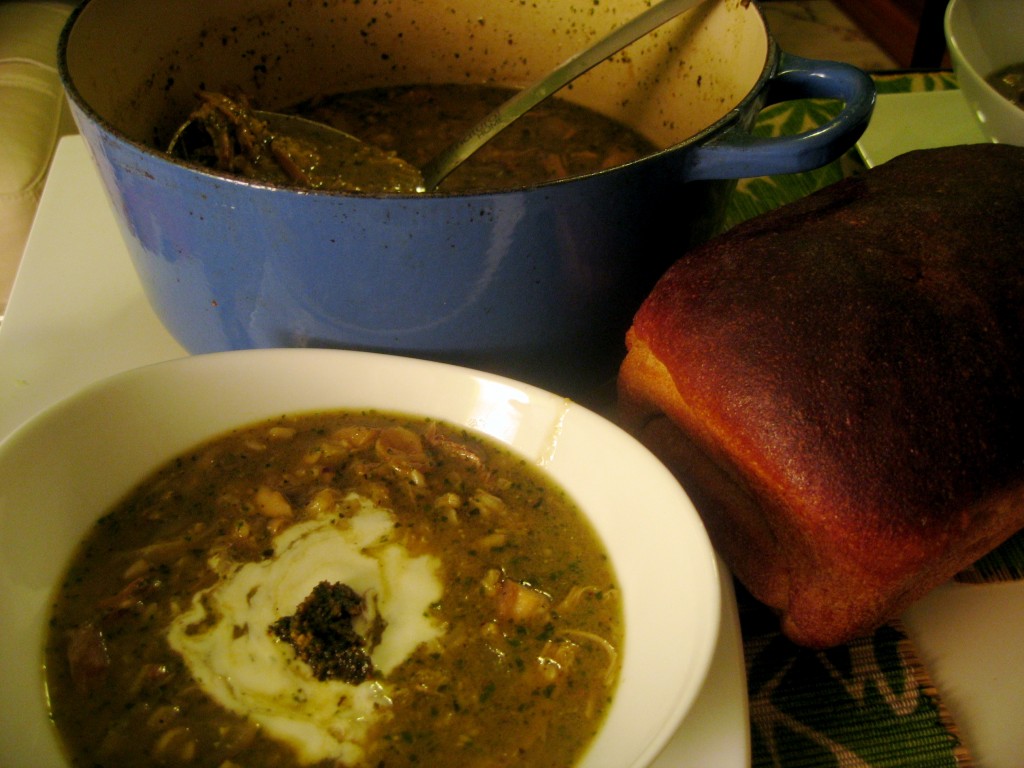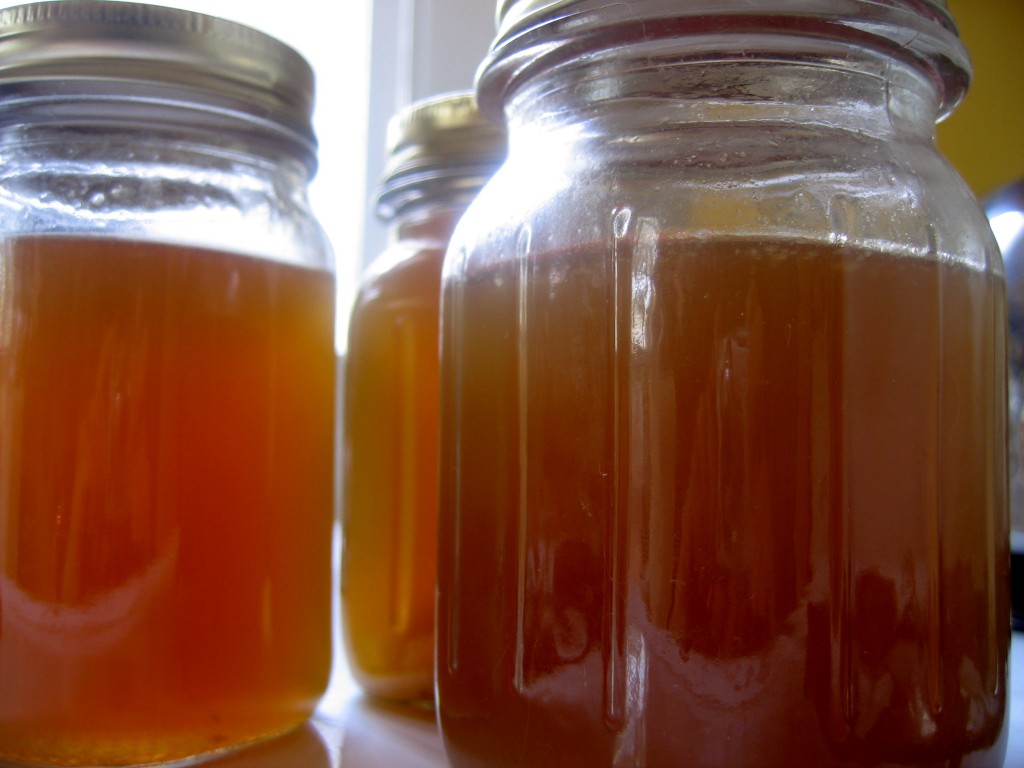
The weather here has shown an uncharacteristic propensity for white this winter. While she often indulges in her love for the sparkly white of frosts, she usually only dons the honest-to-God white stuff every four or five years. This season, which isn’t over yet, she has waltzed out in the swirly white dress no less than twice.
While I fully intended to make the trek to the farm, it seems that pregnant scooter-riding farmers get a snow day. With the unexpected day off, my thoughts turned to good snow day activities. I was having trouble staying warm… it seems Hemingway is taking all my body heat too. So, instead of going all the way outside, we did our snow activities from the window. While Mr. Quotidian held the window open, I leaned out and made our snow avatars. A tall snowman in Mr. Quotidian’s likeness was easy enough, but I had trouble with the pregnant snowife. So, as a compromise, I fashioned a little Hemingway snowman separately.

Nothing could be more of a soup day than a snow day, so I turned my attention towards dinner. For me, soup must include two things if it’s to be classified as a snow day soup. It must be based on real broth that has been simmering all day, and it must not require any ingredients other than what’s already in my fridge, freezer, or pantry. (Extra points for being able to use leftovers.) The requirements, though they might seem random, actually have some reason behind them. The on-hand ingredients stipulation is for the obvious reason that on a snow day you either can’t or don’t want to make the journey to the grocery store. The broth specification has to do with the anticipation factor. Snow days typically involve long stints under blankets punctuated by brief stints of outdoor frivolity. When I’m home all day, there’s something about slowly becoming aware of the aroma of stock simmering on the stove, attending it throughout the day, and then enjoying the rewards at the end of the day. That pleasure is compounded when my hands are cold from snow and they slowly thaw as I stir the stock, leaning next to a warm stove. Obviously these aren’t real conditions and don’t absolutely have to be followed to have a successful soup. For me, they are just what distinguishes a Snow Day Soup from any other run of the mill soup.
I just happened to have a leftover whole chicken and some rice from last week that was practically begging to be made into soup. In the morning, I picked all the meat from the bones and set the stock to simmer. Later that evening, I sauteed some onions and garlic and stole a few ladle-fuls of the stock, leaving the rest to simmer overnight. I also added a bit of leftover whey to up the protein content (pregnant you know). Because I had time to spare, I added what I consider one of the secret weapons of a good soup: a Parmesan rind. These take awhile to melt in, but can’t be outdone in the savoriness and body they add to soup. When the rind was melted, I added the cooked rice and shredded chicken. Then, at the last minute to preserve its color, I added a couple spoonfuls of homemade pesto. Perfect. Even though I hadn’t been out playing in the snow all day, this soup bore the same sense of comfort and well-being that a hot meal did after my childhood snow days. With this soup, the weather can wear white all she likes.

Snow Day Pesto Chicken and Rice Soup
1 onion, chopped
3 cloves of garlic, grated or chopped
2 Tbs butter
1 quart chicken stock (opt. part whey)
1 hunk Parmesan cheese rind
2-3 cups leftover chicken
1-2 cups cooked rice
2 Tbs pesto
salt and pepper
yogurt, sour cream, creme fraiche
In a medium pot, melt the butter. When is sizzles, add the onions and garlic with a pinch of salt. Stir to coat them with the butter. Let them cook until they start to soften. Add the broth and cheese rind. Bring to a boil, reduce heat to a simmer, cover the pot, and let simmer until the rind is melted into the stock. If you have a few stubborn bits that refuse to melt, just fish them out. Add the chicken and rice and cook till heated through. Right before serving, add the pesto. If you add it too far in advance, it will loose its vibrant green. Taste and season with salt and pepper. Serve with a swirl of yogurt and a dollop of extra pesto.
Posted 14 years ago at 7:06 am. Add a comment
 Since writing about why I cook, I’ve been thinking about the all the transformations inherent in cooking. In that post, I compare cooking to alchemy, the process of perfecting a base metal (lead) until it turns into a valuable commodity (gold). Making stock might be the best example of kitchen alchemy at work. It takes probably the basest of all ingredients- an old chicken carcass and vegetable scraps- and transforms them into liquid gold for your kitchen. Consommé, a type of clear stock, actually has the same root as “consummate”- both mean to bring something to perfection. Regardless of the metaphorical significance such a process may have, stock is a basic, if endangered, kitchen skill.
Since writing about why I cook, I’ve been thinking about the all the transformations inherent in cooking. In that post, I compare cooking to alchemy, the process of perfecting a base metal (lead) until it turns into a valuable commodity (gold). Making stock might be the best example of kitchen alchemy at work. It takes probably the basest of all ingredients- an old chicken carcass and vegetable scraps- and transforms them into liquid gold for your kitchen. Consommé, a type of clear stock, actually has the same root as “consummate”- both mean to bring something to perfection. Regardless of the metaphorical significance such a process may have, stock is a basic, if endangered, kitchen skill.
Continue Reading…
Posted 14 years, 10 months ago at 7:43 pm. 3 comments
For the fowl:
1 bird of your choice
1-3 oranges, limes, lemons, ect
1 stick of butter, divided
2 tbs of dried herbs (we used rosemary)
1-2 cloves of garlic
1 tbs oil
salt
For the gravy:
all the drippings from the bird
1/4-1/2 cup wine or vinegar
2-8 cups stock
1/2 cup water
1-2 tbs flour, cornstarch, or arrowroot powder
1-2 tbs herbs
salt
pepper
Preheat your oven to 400°. Melt butter and let cool slightly. Thoroughly thaw your bird and remove any giblets from the cavity. Either store the giblets in the fridge for later use or boil them in a pot of water for an hour to use in the gravy. Pat the bird dry with paper towels or a clean dish cloth. Place it on the rack of you roasting pan or use carrots and celery to build a rack in the bottom of your biggest baking pan, ideally one that can go on the stovetop as well. A big pot would work too, if you don’t have a burner safe pan.
Roll the oranges gently on the counter to release their juices. Cut them in half and place them in the cavity. Don’t stuff them too compactly though, or it will affect the cooking time of the bird.
In an small bowl or mortar grind the herbs. Add minced garlic, a pinch of salt, and a drizzle of oil. Gently loosen the bird’s skin with your fingers. Try not to tear it. Using your fingertips, rub the herb and garlic mixture under the skin as evenly as possible. Reserve any extra for the gravy. Skin is a barrier Then massage the bird all over with the melted butter. You can use your hands for this or a pastry brush. I prefer my hands for more even coverage. If you are using unsalted butter, you might want to sprinkle a little salt over the skin too.
When the bird is thoroughly greased, spread him out like he’s sunbathing; pull the wings and legs out from the body. This will give you crispy skin all over. If you have one, insert a probe thermometer into the deepest part of the breast, making sure to not hit any bones, which would give an inaccurate temperature. Set the alarm to go off at 160°. Put the bird in the oven and immediately reduce the heat to 350°. High heat at the beginning helps the fat essentially fry the skin as it renders. But having high heat for too long will leave the skin burnt and the meat raw.
When the breast has reached 160°, test the thigh meat on the opposite side. Remove the bird from the oven and place it on a pan or cookie sheet to rest. Use your roasting rack to keep the bottom from getting soggy. The resting period is essential. Do not skip it! Straight from the oven, all the yummy meat juices are loose. They would run out if you cut it, leaving you with dry meat. During the resting period, the meat reabsorbs the juices and leaves you with beautiful succulent meat. A turkey needs to rest at least 30 minutes, a chicken at least 10 minutes. If you are worried it will get too cold, loosely tent a piece of foil over it.
While the bird is resting, make the gravy. If you want to see the proper method to make gravy, go look it up on your favorite cooking site, because I cheat and don’t skim the fat off first. Straddle your pan over two burner and turn them on high. When things start to sizzle, which shouldn’t be too long, deglaze the pan by pour in the wine/vinegar. Using a wooden spoon, scrape up all the little brown bits. Not only are they not burned, they are incredibly flavorful caramelized juices from the meat. Believe me, you want them in your gravy! Once you have them all scraped up, add your stock. This is where you get the volume in the gravy. So, if you have a big crowd, at a lot of stock. If it’s just a few people, add less. A good guideline might be 3/4 to 1 cup per person, to allow for evaporation (and leftovers).
Next, mix your starch (flour, cornstarch, arrowroot powder) into about 1/4 cup of water. This mixture is referred to as a slurry. Adding the starch this way prevents it from turning lumpy in your gravy. Add the slurry to the gravy and mix thoroughly. Some starches take awhile to take effect, so let it simmer for a good 5 minutes before adding more. When your gravy is thickened to your liking, add a couple pinches of salt, a grind or two of fresh pepper, and any herbs (like the extra from the spice rub). Simmer for another minute to let the flavors meld. The key to good gravy is to taste early and often. Get used to how the flavors develop. Then remove to a gravy boat or other serving vessel (I use a cream pitcher). You can stick it in the oven to keep warm.
Now back to the bird. After it has rested, it’s time to carve. This takes practice! Don’t expect to do it at the table until you are more proficient at carving. The first several times you do it, expect it to be a hacked up job. Just focus on learning where the joints are and the overall process. Since a picture is worth a thousand words (and a video even more), here is a link to a video explaining how to carve a chicken.
If the worst should happen:
If you carve your bird and it is not cooked in the middle, do not panic. Simply finish carving the bird and put the pieces on an oven safe plate, cover in foil, and place it back in the oven until it’s done. You might end up with slightly drier meat, but that’s okay, because you have awesome gravy.
Posted 15 years, 1 month ago at 10:48 pm. Add a comment




